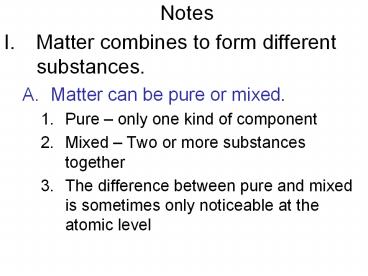Notes - PowerPoint PPT Presentation
1 / 10
Title: Notes
1
Notes
- Matter combines to form different substances.
- Matter can be pure or mixed.
- Pure only one kind of component
- Mixed Two or more substances together
- The difference between pure and mixed is
sometimes only noticeable at the atomic level
2
Notes
- Elements- pure
- A substance that contains only one type of atom
- Compounds- mixed
- A substance that contains two or more types of
atoms bonded together - Mixed on the atomic level, but pure if only one
type of molecule. - Mixtures- mixed
- A combination of different substances in which
each substance keeps its own identity - Homogeneous Same throughout.
- Heterogeneous Different throughout.
3
Notes
- Comparing mixtures and compounds
- Substances in mixtures remain the same substances
- Compounds are new substances
- Mixtures can be separated by physical means
- Compound bonds must be broken
- Compounds have a uniform consistency throughout.
4
- Pop Quiz
- Define the word element
- Define the word compound.
- Define the word mixture
- Define the prefix Hetero-.
- Define the prefix Homo-.
- Explain how to tell the difference between a
compound and a mixture.
5
Notes
- Matter exists in different physical states.
- Particle arrangement and motion determine the
state of matter. - States of matter different forms in which
matter can exist. - The substance does not change, the arrangement of
the particles changes.
6
Notes
- Solid, liquid and gas are common states of
matter. - Solid Fixed volume and shape.
- Close patterned arrangement
- Liquid Fixed volume not shape.
- Close unfixed arrangement
- Extra space from solid that allows fluidity
- Gas No fixed volume or shape.
- Lots of space disorganized arrangement
- Can move easily in any direction
7
Notes
- Solids have a definite volume and shape.
- Shape stays the same and volume can be measured.
- Molecules have fixed positions.
- Cannot move from one part of the solid to
another. - Particles are sometimes arranged in patterns and
sometimes not.
8
Notes
- Liquids have a definite volume but no definite
shape. - Volume can be measured.
- Shape depends on the container.
- Molecules move freely.
- Can move from one part of the liquid to another.
9
Notes
- Gases have no definite volume or shape.
- Volume changes to the volume of the container.
- Gas composition.
- Molecules are far apart, but the space can be
reduced. - The smaller the container the less space.
10
Notes
- Gas behavior.
- Higher pressure lower volume at consistent
temperature. - Higher temperature higher pressure at
consistent volume. - Higher temperature higher volume at consistent
pressure.































